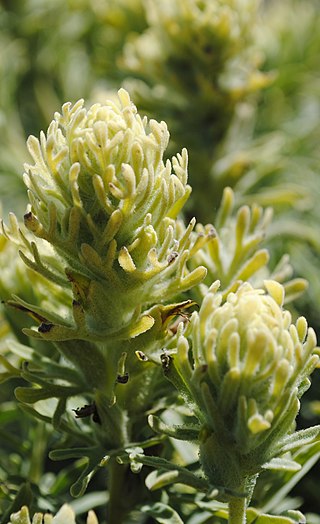
The Tiburon paintbrush or Tiburon Indian paintbrush is an endangered taxon of flowering plant in the family Orobanchaceae. It is endemic to the San Francisco Bay Area in California in the United States, where it occurs in Marin, Napa, and Santa Clara Counties.

Castilleja angustifolia is a species of wildflower known by the common names northwestern Indian paintbrush and desert Indian paintbrush. It is an herbaceous perennial native to the desert, scrublands, and woodlands of western North America. It grows in hot sandy soils and rock crevices in dry conditions.

Castilleja affinis is a species of Castilleja known by the common name coast Indian paintbrush.

Castilleja attenuata is a species of Indian paintbrush, known by the common names valley tassels, attenuate Indian paintbrush, and narrowleaf Owl's-clover. It is native to western North America from British Columbia, through California, to Baja California, where it grows in grasslands and open woodland habitats.

Castilleja campestris is a species of Indian paintbrush known by the common name vernal pool Indian paintbrush. It is native to California and southern Oregon, where it grows in seasonally moist habitat, especially vernal pools.

Castilleja cinerea is a species of Indian paintbrush known by the common name ashgray Indian paintbrush. It is endemic to San Bernardino County, California, where it is known only from the San Bernardino Mountains. There are about 20 occurrences known.

Castilleja densiflora is a herbaceous flowering plant species known by the common names denseflower Indian paintbrush or white / denseflower owlclover. Like other members of the Indian paintbrushes, it is a root-parasite. It is native to California and northern Baja California, where it grows in grassland and chaparral habitat. It is a variable species. It is generally 10 to 40 centimeters tall with linear or lance-shaped leaves up to 8 centimeters long, and with or without lobes. The inflorescence is as small as 3 centimeters or as long as 25 centimeters in length, and has bracts tipped in white to dull or bright pink or purple. Between the bracts appear the flowers, which are somewhat rounded and pouched, and white to yellow to pink or purple in color.

Castilleja grisea is a rare species of Indian paintbrush known by the common name San Clemente Island Indian paintbrush. It is endemic to San Clemente Island, one of the Channel Islands of California. San Clemente Island is owned by the US Navy so the Navy is involved in a management program to recover this species.
Castilleja lasiorhyncha is a species of Indian paintbrush is endemic to southern California known by the common name San Bernardino Mountains Indian paintbrush. Most of the plant's range is in the San Bernardino Mountains, where it grows in forests and meadows.

Castilleja mendocinensis is a species of Indian paintbrush known by the common name Mendocino Coast Indian paintbrush.

Castilleja miniata is a species of Indian paintbrush known by the common name giant red Indian paintbrush. It is native to western North America from Alaska to Ontario to California to New Mexico, where it grows usually in moist places in a wide variety of habitat types.

Castilleja parviflora is a species of Indian paintbrush known by the common name mountain Indian paintbrush. It is native to western North America from Alaska to California, where it grows in high mountain habitat, including areas of alpine climate.

Castilleja subinclusa is a species of Indian paintbrush known by the common names longleaf Indian paintbrush and Franciscan paint brush.

Castilleja levisecta is a rare species of flowering plant in the family Orobanchaceae known by the common name golden paintbrush, or golden Indian paintbrush, listed under the Endangered Species Act in 1997. It is native to British Columbia and Washington, where it is known from eleven remaining populations. It occurred in Oregon but all natural occurrences there have been extirpated. It has been reintroduced to a few areas in Oregon, but it remains to be seen if the plants will survive. The plant is a federally listed endangered species of Canada and was listed as threatened in the United States in 1997. On June 30, 2021, the plant was proposed for delisting due to recovery. Effective August 18, 2023, the U.S. Fish and Wildlife Service issued a rule removing golden paintbrush from the Federal List of Endangered and Threatened Plants

Castilleja septentrionalis is a species of Indian paintbrush known by several common names, including northern paintbrush, sulfur paintbrush, and pale painted cup. There is taxonomic disagreement as to if it is one species widely distributed in mountain and alpine environments of North America or if there is a second species, Castilleja sulphurea, in the Rocky Mountains.

Castilleja integra, with the common names orange paintbrush, Southwestern paintbrush, and wholeleaf paintbrush, is a partially parasitic herbaceous perennial plant native to the Southwestern United States and Northern Mexico. The species produces a relatively large amount of nectar and is attractive to hummingbirds. It is better suited to cultivation than most other species in the paintbrush genus (Castilleja) and is therefor used in xeriscape gardens and naturalistic meadows, even outside its native range.
Castilleja kerryana is a species of flowering plant in the family Orobanchaceae. It is commonly known as Kerry's Indian paintbrush or Kerry’spaintbrush. It was formally described in 2013 and so far it is known only from a small population in the state of Montana, in the Northwestern United States.

Castilleja rhexiifolia, commonly called rosy paintbrush, subalpine paintbrush, or rhexia-leaved paintbrush, is a species of plant in Orobanchaceae, commonly known as the broomrape family. They are a common flower found in moist habitats near or above timberline in the Rocky Mountains and the Pacific Northwest. Like most members of the Castilleja genus, they are partially parasitic plants.

















